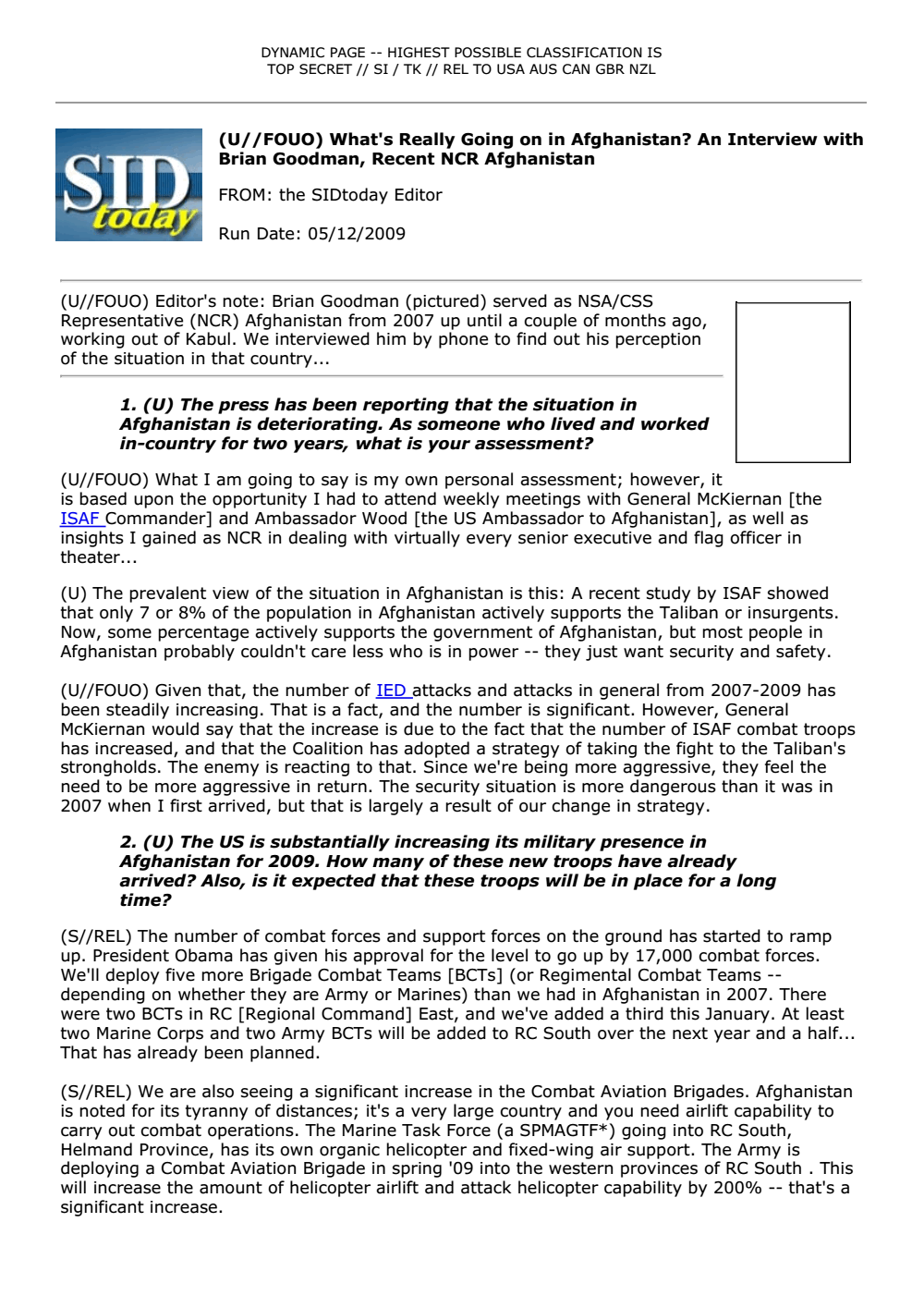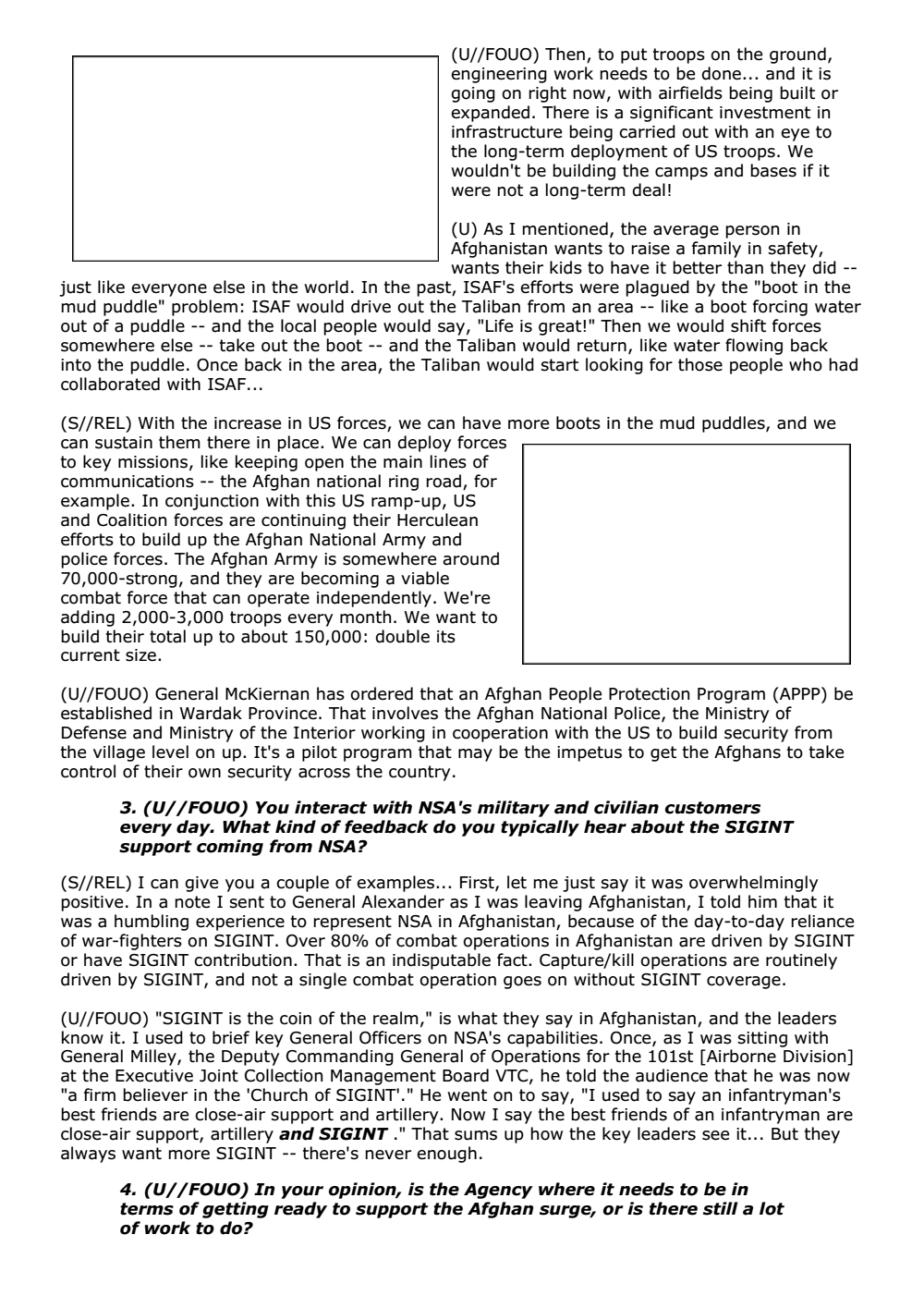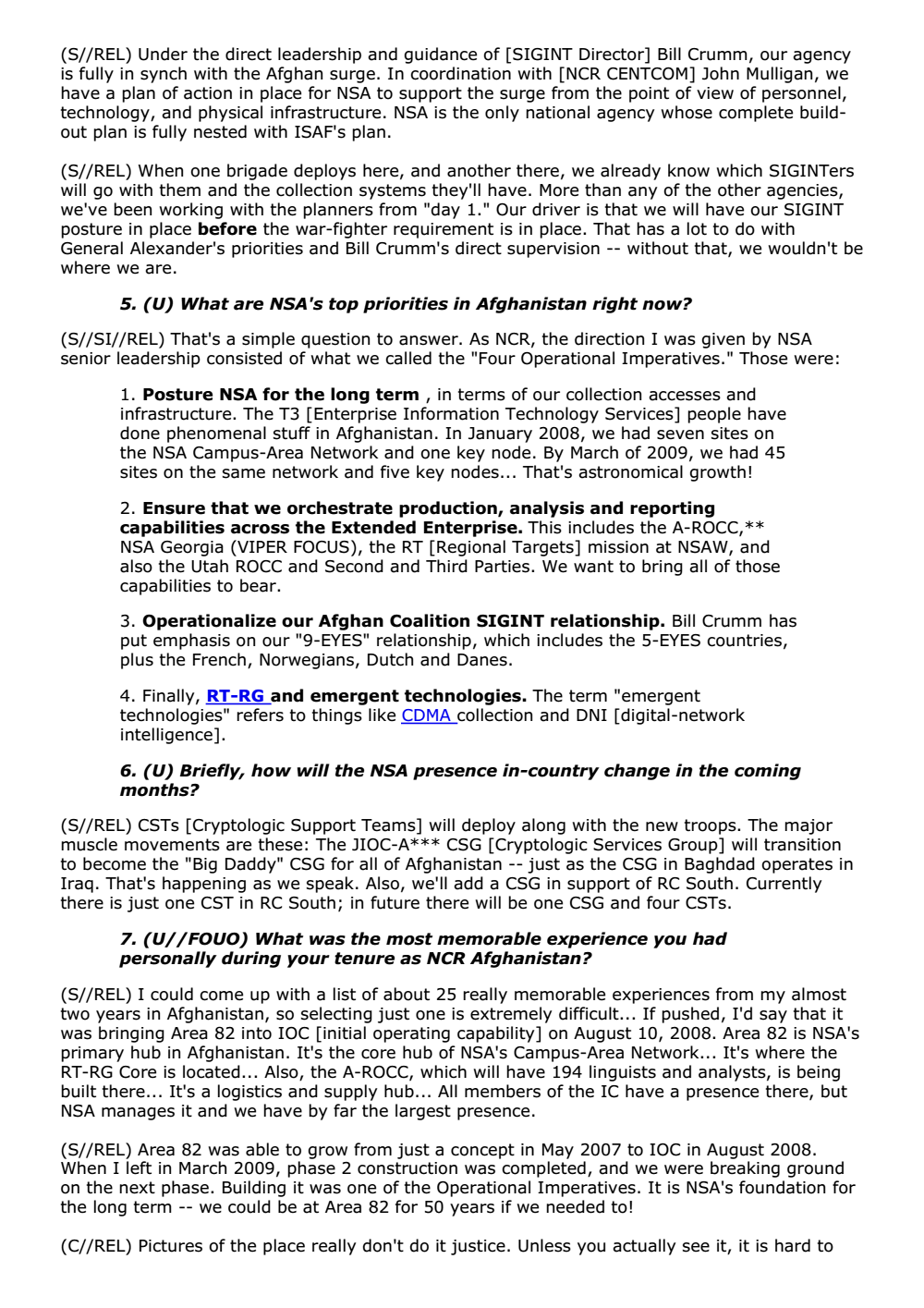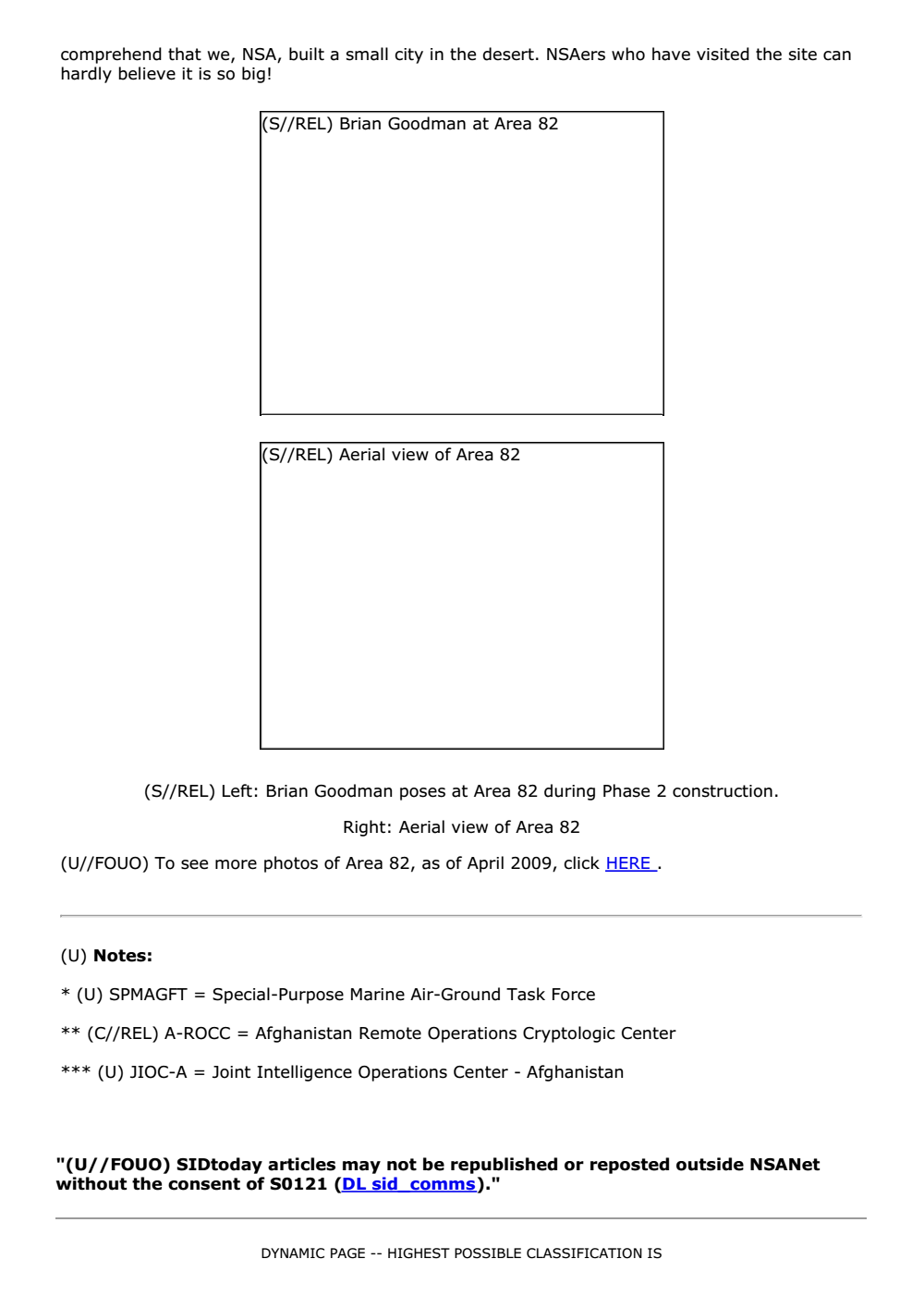
DYNAMIC PAGE -- HIGHEST POSSIBLE CLASSIFICATION IS
TOP SECRET // SI / TK // REL TO USA AUS CAN GBR NZL
(U//FOUO) What's Really Going on in Afghanistan? An Interview with
Brian Goodman, Recent NCR Afghanistan
FROM: the SIDtoday Editor
Run Date: 05/12/2009
(U//FOUO) Editor's note: Brian Goodman (pictured) served as NSA/CSS
Representative (NCR) Afghanistan from 2007 up until a couple of months ago,
working out of Kabul. We interviewed him by phone to find out his perception
of the situation in that country...
1. (U) The press has been reporting that the situation in
Afghanistan is deteriorating. As someone who lived and worked
in-country for two years, what is your assessment?
(U//FOUO) What I am going to say is my own personal assessment; however, it
is based upon the opportunity I had to attend weekly meetings with General McKiernan [the
ISAF Commander] and Ambassador Wood [the US Ambassador to Afghanistan], as well as
insights I gained as NCR in dealing with virtually every senior executive and flag officer in
theater...
(U) The prevalent view of the situation in Afghanistan is this: A recent study by ISAF showed
that only 7 or 8% of the population in Afghanistan actively supports the Taliban or insurgents.
Now, some percentage actively supports the government of Afghanistan, but most people in
Afghanistan probably couldn't care less who is in power -- they just want security and safety.
(U//FOUO) Given that, the number of IED attacks and attacks in general from 2007-2009 has
been steadily increasing. That is a fact, and the number is significant. However, General
McKiernan would say that the increase is due to the fact that the number of ISAF combat troops
has increased, and that the Coalition has adopted a strategy of taking the fight to the Taliban's
strongholds. The enemy is reacting to that. Since we're being more aggressive, they feel the
need to be more aggressive in return. The security situation is more dangerous than it was in
2007 when I first arrived, but that is largely a result of our change in strategy.
2. (U) The US is substantially increasing its military presence in
Afghanistan for 2009. How many of these new troops have already
arrived? Also, is it expected that these troops will be in place for a long
time?
(S//REL) The number of combat forces and support forces on the ground has started to ramp
up. President Obama has given his approval for the level to go up by 17,000 combat forces.
We'll deploy five more Brigade Combat Teams [BCTs] (or Regimental Combat Teams -depending on whether they are Army or Marines) than we had in Afghanistan in 2007. There
were two BCTs in RC [Regional Command] East, and we've added a third this January. At least
two Marine Corps and two Army BCTs will be added to RC South over the next year and a half...
That has already been planned.
(S//REL) We are also seeing a significant increase in the Combat Aviation Brigades. Afghanistan
is noted for its tyranny of distances; it's a very large country and you need airlift capability to
carry out combat operations. The Marine Task Force (a SPMAGTF*) going into RC South,
Helmand Province, has its own organic helicopter and fixed-wing air support. The Army is
deploying a Combat Aviation Brigade in spring '09 into the western provinces of RC South . This
will increase the amount of helicopter airlift and attack helicopter capability by 200% -- that's a
significant increase.

(U//FOUO) Then, to put troops on the ground,
engineering work needs to be done... and it is
going on right now, with airfields being built or
expanded. There is a significant investment in
infrastructure being carried out with an eye to
the long-term deployment of US troops. We
wouldn't be building the camps and bases if it
were not a long-term deal!
(U) As I mentioned, the average person in
Afghanistan wants to raise a family in safety,
wants their kids to have it better than they did -just like everyone else in the world. In the past, ISAF's efforts were plagued by the "boot in the
mud puddle" problem: ISAF would drive out the Taliban from an area -- like a boot forcing water
out of a puddle -- and the local people would say, "Life is great!" Then we would shift forces
somewhere else -- take out the boot -- and the Taliban would return, like water flowing back
into the puddle. Once back in the area, the Taliban would start looking for those people who had
collaborated with ISAF...
(S//REL) With the increase in US forces, we can have more boots in the mud puddles, and we
can sustain them there in place. We can deploy forces
to key missions, like keeping open the main lines of
communications -- the Afghan national ring road, for
example. In conjunction with this US ramp-up, US
and Coalition forces are continuing their Herculean
efforts to build up the Afghan National Army and
police forces. The Afghan Army is somewhere around
70,000-strong, and they are becoming a viable
combat force that can operate independently. We're
adding 2,000-3,000 troops every month. We want to
build their total up to about 150,000: double its
current size.
(U//FOUO) General McKiernan has ordered that an Afghan People Protection Program (APPP) be
established in Wardak Province. That involves the Afghan National Police, the Ministry of
Defense and Ministry of the Interior working in cooperation with the US to build security from
the village level on up. It's a pilot program that may be the impetus to get the Afghans to take
control of their own security across the country.
3. (U//FOUO) You interact with NSA's military and civilian customers
every day. What kind of feedback do you typically hear about the SIGINT
support coming from NSA?
(S//REL) I can give you a couple of examples... First, let me just say it was overwhelmingly
positive. In a note I sent to General Alexander as I was leaving Afghanistan, I told him that it
was a humbling experience to represent NSA in Afghanistan, because of the day-to-day reliance
of war-fighters on SIGINT. Over 80% of combat operations in Afghanistan are driven by SIGINT
or have SIGINT contribution. That is an indisputable fact. Capture/kill operations are routinely
driven by SIGINT, and not a single combat operation goes on without SIGINT coverage.
(U//FOUO) "SIGINT is the coin of the realm," is what they say in Afghanistan, and the leaders
know it. I used to brief key General Officers on NSA's capabilities. Once, as I was sitting with
General Milley, the Deputy Commanding General of Operations for the 101st [Airborne Division]
at the Executive Joint Collection Management Board VTC, he told the audience that he was now
"a firm believer in the 'Church of SIGINT'." He went on to say, "I used to say an infantryman's
best friends are close-air support and artillery. Now I say the best friends of an infantryman are
close-air support, artillery and SIGINT ." That sums up how the key leaders see it... But they
always want more SIGINT -- there's never enough.
4. (U//FOUO) In your opinion, is the Agency where it needs to be in
terms of getting ready to support the Afghan surge, or is there still a lot
of work to do?

(S//REL) Under the direct leadership and guidance of [SIGINT Director] Bill Crumm, our agency
is fully in synch with the Afghan surge. In coordination with [NCR CENTCOM] John Mulligan, we
have a plan of action in place for NSA to support the surge from the point of view of personnel,
technology, and physical infrastructure. NSA is the only national agency whose complete buildout plan is fully nested with ISAF's plan.
(S//REL) When one brigade deploys here, and another there, we already know which SIGINTers
will go with them and the collection systems they'll have. More than any of the other agencies,
we've been working with the planners from "day 1." Our driver is that we will have our SIGINT
posture in place before the war-fighter requirement is in place. That has a lot to do with
General Alexander's priorities and Bill Crumm's direct supervision -- without that, we wouldn't be
where we are.
5. (U) What are NSA's top priorities in Afghanistan right now?
(S//SI//REL) That's a simple question to answer. As NCR, the direction I was given by NSA
senior leadership consisted of what we called the "Four Operational Imperatives." Those were:
1. Posture NSA for the long term , in terms of our collection accesses and
infrastructure. The T3 [Enterprise Information Technology Services] people have
done phenomenal stuff in Afghanistan. In January 2008, we had seven sites on
the NSA Campus-Area Network and one key node. By March of 2009, we had 45
sites on the same network and five key nodes... That's astronomical growth!
2. Ensure that we orchestrate production, analysis and reporting
capabilities across the Extended Enterprise. This includes the A-ROCC,**
NSA Georgia (VIPER FOCUS), the RT [Regional Targets] mission at NSAW, and
also the Utah ROCC and Second and Third Parties. We want to bring all of those
capabilities to bear.
3. Operationalize our Afghan Coalition SIGINT relationship. Bill Crumm has
put emphasis on our "9-EYES" relationship, which includes the 5-EYES countries,
plus the French, Norwegians, Dutch and Danes.
4. Finally, RT-RG and emergent technologies. The term "emergent
technologies" refers to things like CDMA collection and DNI [digital-network
intelligence].
6. (U) Briefly, how will the NSA presence in-country change in the coming
months?
(S//REL) CSTs [Cryptologic Support Teams] will deploy along with the new troops. The major
muscle movements are these: The JIOC-A*** CSG [Cryptologic Services Group] will transition
to become the "Big Daddy" CSG for all of Afghanistan -- just as the CSG in Baghdad operates in
Iraq. That's happening as we speak. Also, we'll add a CSG in support of RC South. Currently
there is just one CST in RC South; in future there will be one CSG and four CSTs.
7. (U//FOUO) What was the most memorable experience you had
personally during your tenure as NCR Afghanistan?
(S//REL) I could come up with a list of about 25 really memorable experiences from my almost
two years in Afghanistan, so selecting just one is extremely difficult... If pushed, I'd say that it
was bringing Area 82 into IOC [initial operating capability] on August 10, 2008. Area 82 is NSA's
primary hub in Afghanistan. It's the core hub of NSA's Campus-Area Network... It's where the
RT-RG Core is located... Also, the A-ROCC, which will have 194 linguists and analysts, is being
built there... It's a logistics and supply hub... All members of the IC have a presence there, but
NSA manages it and we have by far the largest presence.
(S//REL) Area 82 was able to grow from just a concept in May 2007 to IOC in August 2008.
When I left in March 2009, phase 2 construction was completed, and we were breaking ground
on the next phase. Building it was one of the Operational Imperatives. It is NSA's foundation for
the long term -- we could be at Area 82 for 50 years if we needed to!
(C//REL) Pictures of the place really don't do it justice. Unless you actually see it, it is hard to

comprehend that we, NSA, built a small city in the desert. NSAers who have visited the site can
hardly believe it is so big!
(S//REL) Brian Goodman at Area 82
(S//REL) Aerial view of Area 82
(S//REL) Left: Brian Goodman poses at Area 82 during Phase 2 construction.
Right: Aerial view of Area 82
(U//FOUO) To see more photos of Area 82, as of April 2009, click HERE .
(U) Notes:
* (U) SPMAGFT = Special-Purpose Marine Air-Ground Task Force
** (C//REL) A-ROCC = Afghanistan Remote Operations Cryptologic Center
*** (U) JIOC-A = Joint Intelligence Operations Center - Afghanistan
"(U//FOUO) SIDtoday articles may not be republished or reposted outside NSANet
without the consent of S0121 (DL sid_comms)."
DYNAMIC PAGE -- HIGHEST POSSIBLE CLASSIFICATION IS

TOP SECRET // SI / TK // REL TO USA AUS CAN GBR NZL
DERIVED FROM: NSA/CSSM 1-52, DATED 08 JAN 2007 DECLASSIFY ON: 20320108